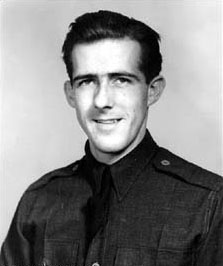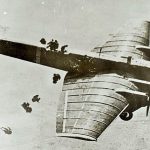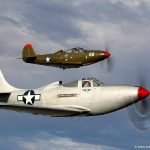
By Pete Mecca
Analogous to Mohammad Ali and Joe Frazier, Richard Ira “Dick” Bong and Thomas Buchanan McGuire were the heavyweight fighter jocks of World War II. Unlike Ali and Frazier, the two fighter aces were heavyweights due to their skills and kills behind the stick of the P-38 Lightning, not due to their physical stature or strength. Likewise, Bong and McGuire did not fight each other, they fought against the Japanese. Yet their competition for America’s “Top Gun” became front page news, just like Ali and Frazier’s “Thrilla in Manila” in 1975.
Bong and McGuire did not wage their war in the confines of Madison Square Garden; their ring was the vastness of the Pacific Ocean. Both did, however, have an identical knockout punch: The legendary twin boom fighter, the P-38 Lightning. Designed by Lockheed’s aeronautical innovator, Kelly Johnson, the Lightning could deliver a sucker punch or hit below the belt with four nose-mounted .50 caliber machine guns and one 20mm cannon. Adversaries who faced the P-38 dubbed the aircraft, “The Forked-Tailed Devil.”
She was fast as a devil and quick as lightning, reaching airspeeds at over 400 mph. A bit temperamental, she was nevertheless tough and proved her grit over Dobodura, New Guinea on Dec 27, 1942. Lightnings of the 39th Fighter Squadron tangled with over 60 Japanese fighters. Eleven of the enemy went down while only one P-38 was damaged enough to be scrapped after crash-landing. Then on March 1, 1943, during the Battle of the Bismarck Sea, P-38s bushwhacked eight Japanese troop ships with an escort of eight destroyers and 30 Zeroes utilized for air cover. All eight troop ships and a destroyer were sunk, along with the destruction of 15 to 20 of the Zeroes. Only two Lightnings were lost.
With an aggressive flyboy behind the controls, the Lightning outfought and outflew anything the Japanese could put in the air. Two of those flyboys, as different as Ali and Frazier, clambered into the cockpits of one P-38 named “Marge,” the other “Pudgy,” and flew into aviation history as America’s top scoring and second highest scoring Aces of all time. And this is their story.
“The duty of a fighter pilot is to patrol his area of sky and shoot down any enemy fighters in that area. Anything else is rubbish.” Baron Manfred Von Richthofen – The Red Baron
Richard Ira “Dick” Bong was born into the farming community of Poplar, Wis., on Sept. 24, 1920. A multi-talented young man, Bong helped farm; played hockey, baseball and basketball along with clarinet in the school band; fished, and was known as a crack shot with a hunting rifle.
As with most boys of the Greatest Generation, Bong was fascinated by those marvelous flying machines and became a fervent model builder. In 1938, Bong attended Superior State Teachers College and enrolled in the Civilian Pilot training agenda. He even took private flying lessons before enlisting in the Army Air Corps in 1941.
In the Army, his flight training began at California’s Rakin Aeronautical Academy followed by basic training at Gardner Field, Calif. Transferred to Luke Field near Phoenix, Ariz., he learned fighter tactics flying the old reliable A-6 trainer. A future U.S. senator and Presidential candidate from Arizona, Capt. Barry Goldwater, was one of Bong’s instructors. Another flight instructor said of Bong, “He is the finest natural pilot I have ever seen.”
After earning his pilot’s wings in January of ’41, Bong schooled gunnery for a few months before reporting to Hamilton Field near San Francisco to master the hottest fighter of the time, the twin-engine P-38. His skill behind the controls caught the attention of Gen. George Kenney, the future commander of the 5th Air Force.
Fighter pilots have a reputation as happy-go-lucky, hotshot devil-may-care aviators with the aggressiveness to match the military’s demand for crème de la crème aviators to fly the expensive airborne weapons platforms. Dick Bong was no exception. On June 12, 1942, he “buzzed” the residence of a recently married pilot, flew down Market Street at extremely low altitude, blew freshly laundered clothes off a woman’s clothes line, and along with three other hotshots “looped” the Golden Gate Bridge.
Gen. Kenney was not a happy camper. He ordered his hotshot pilot to the woman’s house to assist her with laundry plus complete menial chores for a day. Kenney told Bong, “I want this woman to think we are good for something else other than annoying people!” Gen. Kenney added, “If you didn’t want to fly down Market Street I wouldn’t have you in my air force, but you are not to do it again and I mean what I say.”
Bong was grounded while the rest of his group left for England. Outcast temporarily, he was transferred to Hamilton Field for eventual dispatch to the PTO (Pacific Theater of Operations). Bong was assigned to the Flying Knights of the 9th Fighter Squadron, 49th Fighter Group located at Darwin, Australia. There he began his reign of terror against aviators of the Rising Sun. On Dec. 27, 1942, Bong scored his first of many kills when he downed two enemy aircraft during the Battle of Buna-Gona.
Bong’s counterpart, Thomas Buchanan McGuire, was born two months before Bong in Ridgewood, N.J. Unlike the family oriented Bong clan of nine siblings, McGuire’s parents divorced before his 10th birthday and he and his mother relocated to Sebring, Fla. After high school, McGuire became a Georgia Tech Yellow Jacket but quit during his junior year to join the Army Air Corps, like Bong, in 1941.
McGuire trained in Corsicana, Texas, earned his wings at Randolph Field in Texas, but was not the flashiest of pilots. He was matured and blessed with leadership abilities, yet ended up in the Aleutian Islands of Alaska flying combat patrols in a P-39 Airacobra, a relatively successful aircraft. Bored with icy Alaska and the lack of opportunity to engage in combat, McGuire requested then received a transfer to the “real” aerial war.
In February of 1943, McGuire mastered the P-38 at the Orange County Airport in California before receiving orders for 49th Fighter Group. Bong had at least six kills before the two aviators met for the first time at Schwimmer Field near Port Moresby, New Guinea. These two heavyweight fighter pilots took to the air for the most intense “Top Gun” competition of the entire war.
Bong’s P-38 was named Marge, to honor his stylish and beautiful wife. McGuire, also married to a sleek eye-catcher name Marilyn, named his P-38 after his wife’s offbeat nickname, Pudgy.
Bong racked up kills in rapid succession. By August of 1943 his confirmed score was 16, including four in one day while flying escort over Lae on July 26th. Bong was referred to as a fighter-magnet, drawing the attention of enemy fighters as if destined for fame. McGuire, on the other hand, “damaged” five enemy aircraft on March 18, 1943. He claimed one enemy plane as a “probable,” and lost a “confirmed kill” to another pilot by the flip of a coin. Later, McGuire received credit for three confirmed kills in one engagement. Three days later he claimed twp more, making him an “Ace” after only two missions.
Dick Bong was like Mohammad Ali, “floating like a butterfly, stinging like a bee” against his opponents. He would duck for cover if out-gunned or conditions were not favorable for engagements, much like Ali’s tactic of “rope a dope.” Bong calculated a fight before engaging, sought positive odds, and if promising quickly moved in for the kill. His marksmanship, by his own confession, was not reliable. Therefore, he moved in close for the knockout, several times flying through the flaming debris of a downed enemy aircraft. In one encounter Bong collided with the fiery wreckage. His cleverness, confirmed kills, and opportunist tactics gave him unrestrained confidence in combat.
Heavyweight McGuire was more like Joe Frazier; solid, highly effective due to a dedication to recognized rules and an experienced study of his opponents, but perfectly willing and able to slug it out when offered an opportunity. Gen. Kenney recognized McGuire’s leadership abilities and assigned him to lead the 431st Squadron, a decision that may have kept McGuire from becoming America’s “Top Gun” due to all the extra responsibilities heaped on McGuire.
Bong, much like Ali, started tearing down barriers and racking up the victories. He broke Eddie Rickenbacker’s WWI record of 26 confirmed kills on April 12, 1944. Rickenbacker sent Bong a case of scotch. Bong’s boss, Gen. Kenney, sent Bong a case of champagne. Gen. “Hap” Arnold, concerned the incoming booze would be bad publicity for the Air Corps plus aware that Bong was a spin-and-span sort of aviator and pretty much a teetotaler, sent the famous pilot two cases of Coca-Cola. Requests poured in from other squadrons and air groups volunteering to assume ownership of the surplus liquor.
McGuire, much like Frazier, stuck to what he did best, fighting, although the pressures of leadership and intermittent illnesses kept him out of action on occasion. He narrowly escaped death on Oct 17, 1943. Over Oro Bay, New Guinea, McGuire spotted seven Japanese Zeroes ganging up on a lone P-38. He didn’t hesitated and dove on the enemy, shooting down three before the remaining four Zeroes jumped on him. With shot-up controls and severe damage to his P-38, McGuire had to hit the silk at 12,000 feet. His parachute harness became entangled in the cockpit; McGuire fell 11,000 feet before eventually freeing the harness. His wrist suffered a wound during combat; the short fall broke several ribs and caused other injuries … McGuire spent six weeks in a hospital.
In the meantime, Bong’s incredible success as a fighter pilot made him a national hero. He was sent home a couple of times for war bond and publicity tours, but Bong sought combat. He begged to be returned to his unit in New Guinea, won the argument, and took to the air again in May of 1944 as an instructor. Thing is, Bong was never told where to instruct and elected to train new replacements on live targets. Flying out of Tacloban, Leyte, during the Philippine Campaign, Bong claimed his 40th victory by December, an accomplishment earning him a Medal of Honor presented personally by Gen. Douglas MacArthur. Bong’s war was over. Gen. Kenney wanted his hero home, safe, and sent the Ace of Aces packing in January of 1945.
McGuire, however, was well on his way to breaking Bong’s record and taking “Top Gun” honors. In two days, December 25th and 26th of 1944, he shot down seven enemy planes, which pushed his confirmed kills to 38. The same month Bong returned home, Thomas McGuire took to the skies on Jan. 7, 1945, leading 4 P-38 Lightnings on a mission over Negros Island in the central Philippines.
Near the Japanese airfield of Manapla, the P-38s spotted a Japanese Ki-43 Oscar fighter, all by his lonesome. Incredibly, the lone enemy pilot immediately engaged the Lightnings. At the controls of the Oscar was Warrant Officer Akiar Sugimoto, an experienced aviator and famed instructor with over 3,000 hours in the Oscar fighter. In the fog of air combat, Sugimoto ended up on the tail of McGuire’s wingman, Capt. Edwin Weaver. McGuire eased up on his own turn rate in hopes the maneuver would draw Sugimoto off Weaver. The trick worked, but as McGuire increased speed then pulled a hazardous turn rate a mere 300 feet off the ground; Pudgy stalled, flip-flopped, and nosed dived into the ground. McGuire was killed on impact.
Filipinos who witnessed the incident rushed to the crash site to quickly remove McGuire’s body from the P-38 to safeguard his remains from capture. Not until 1947 were McGuire’s remains returned to the United States and reinterred with full military honors at Arlington National Cemetery. Like his competitor, Dick Bong, McGuire was awarded the Medal of Honor … posthumously.
Major Richard Ira “Dick” Bong remained America’s top scoring Ace of all time. He resumed PR tours, sold war bonds, and became a test pilot on Lockheed’s new jet fighter, the P-80 Shooting Star. Shortly after takeoff on a routine flight, the P-80s fuel pump malfunctioned and Bong had to hit the silk. Too close to the ground, his parachute never opened. The United States lost her Ace of Aces on Aug. 6, 1945. Bong’s death was front page news, but his demise was shared with another historic event that day, the story of a B-29 named Enola Gay dropping a new weapon called an atomic bomb on Hiroshima, Japan.
Records indicate both Bong and McGuire had more kills than officially confirmed. No matter. The crème d la crème of aviators were gone – America had lost two of her best.
Dick Bong and Thomas McGuire, like Mohammad Ali and Joe Frazier, were so different, so alike, and so American.
Pete Mecca is a Vietnam veteran. For story consideration visit his website at aveteransstory.us and click on “contact us.”



































